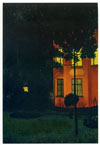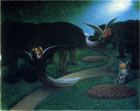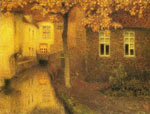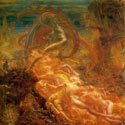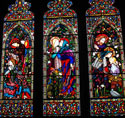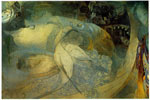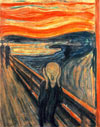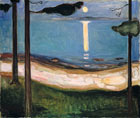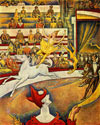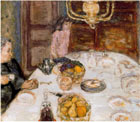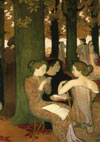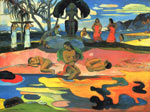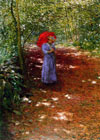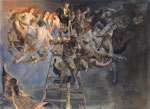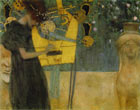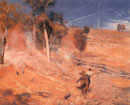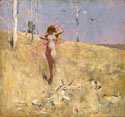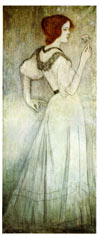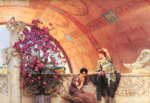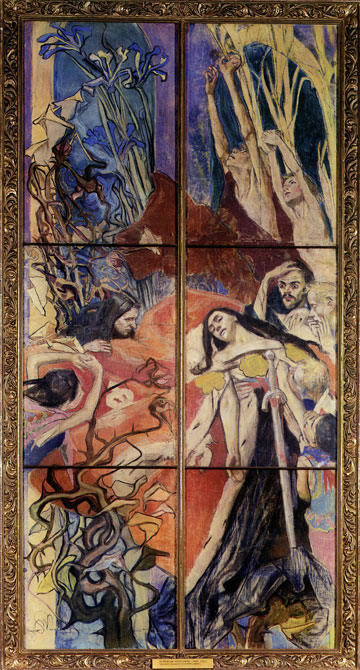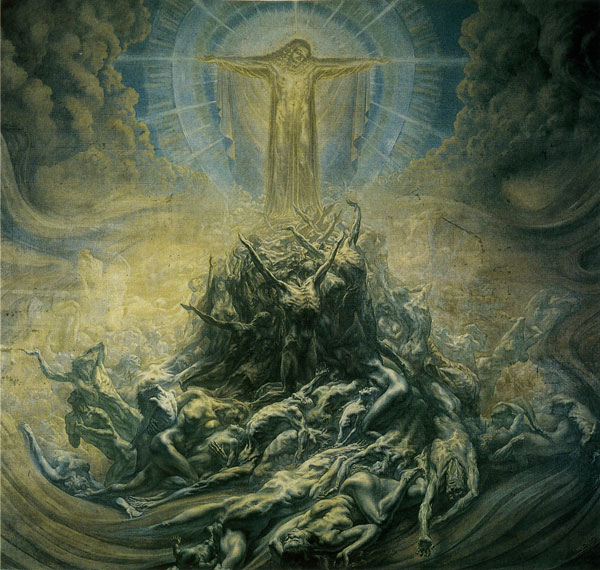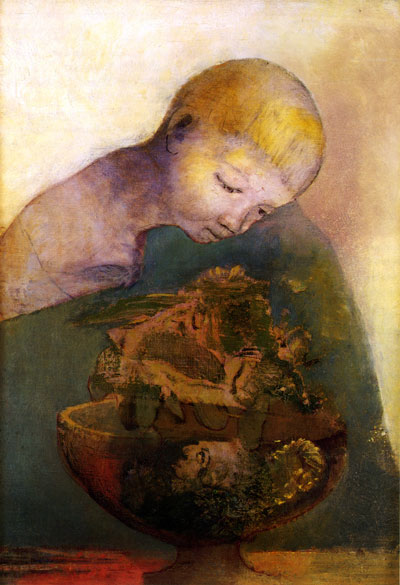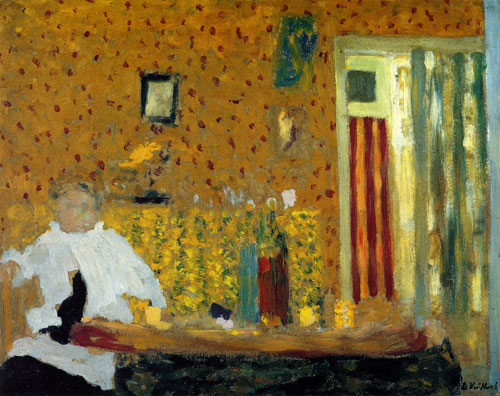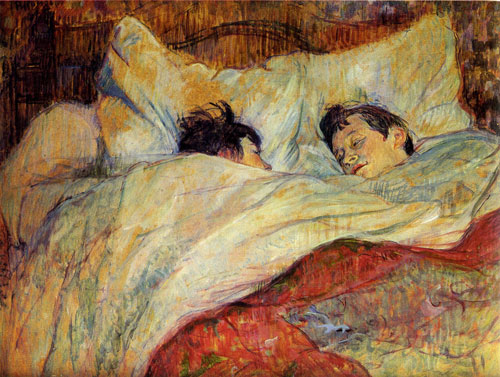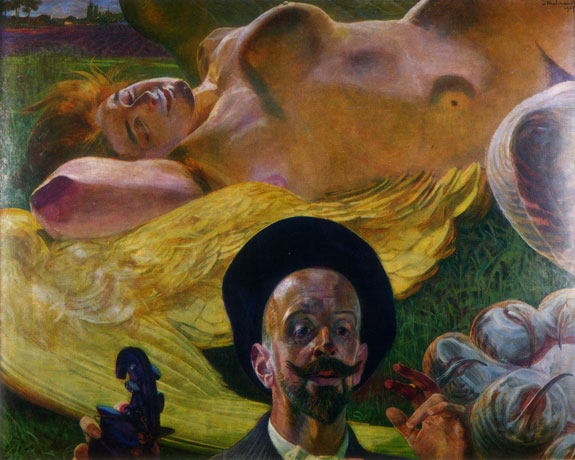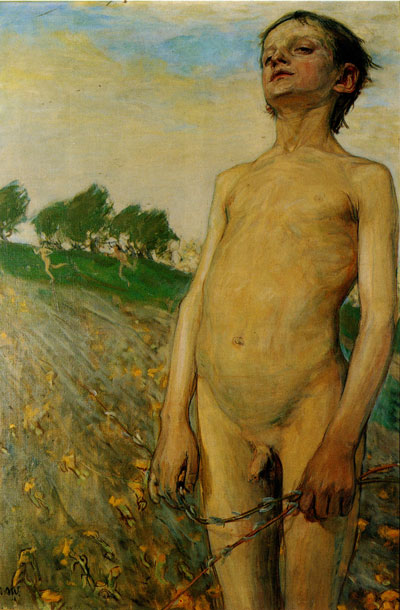
Moving Movements, History of Modern Painting, 1890 - 1900
THE YEARS 1890 - 1900: SYMBOLISM AND ART NOUVEAU PREVAIL
In 1896 Herman Hollerith founded the "Tabulating Machine Company", which later will called IBM. Joseph John Thomson discovered the electron in 1897. In 1897 Alexander Popov used an antenna to broadcast radiowaves.
William de Gouves de Nuncques
The pink house or
the blind house 1992
William de Gouves de Nuncques
The angels of the Night 1894
Ferdinand Khnopff
Head of a Woman 1899
Ferdinand Khnopff
The caressing 1896
Henri Le Sidaner
Dimanche1898
Henri Le Sidaner
Jean Delville
Treasures of Satan1895
Jean Delville
The School of Plato 1898
Edward Coley Burne-Jones
The last Sleep of Arthur in Avalon 1881-98
Edward Coley Burne-Jones
Anunciation, visitation and Nativity (Topcliffe)
Ferdinand Hodler
The Dream 1897
Carlos Schwabe
Virgin of Lillies1998
Walter Crane
Horses of Neptune 1892
Jens Ferdinand Willumsen
Jotumheim 1892-93
Georges De Feure
The Swan Lake ca 1897
Edvard Munch
The screem Sleep 1893
Edvard Munch
Moonlight 1895
Claude Monet
Saint-Germain in the Sun 1894
Georges Seurat
The Circus1894
Henri de Toulouse-Lautrec
Marcelle Lender Dancing the Bolero in 'Chilpéric' 1896
Pierre Bonnard
Lunch at le grand lamps 1899
Maurice Denis
The Muse
in the Bois Sacré 1893
Charles Filiger
Pouldu Landscape1890
Paul Gauguin
Sunday (mahana no atua)1894
Antonin Slavicek
Walking through the park
in the Sun
Jacek Malczewsky
Vicious Circle
(bledne-kolo)1895-97
Jacek Malczewsky
Melancholya
1890-94
Gustave Klimt
Music1895
Tom Roberts
The Break Away 1891
Arthur Streeton
Spirit of the Drought 1895
József Rippl-Rónai
Study for the Gobelin
Tapestry 'Young Woman
with Rose' 1898
Alma-Tadema
Unconscious_Rivals
1893
Swiat Wyspianskiego, Polonia-projekt witraza do Katedry we Lwowie, 1893 - '94 |
Triumph of symbolism Symbolism is one of those unfortunate names for a collection of personal diversity. The many definitions given to it recalls the many differences.
One critic will classify a certain painter as a symbolist, another critic will not.
In the art books we can find Munch classified with Neo-Impressionism, symbolism, Art Nouveau or forerunner of expressionism, while he also looks as a Nabi. Symbolist painters can work in very different techniques and styles. Furthermore some painters made symbolist between other works. |
Jean Delville, The God-man, ca. 1901 - '03 |
Another upcoming subject, sexuality, was treated in many different ways. The bourgeoisie found pleasure in symbolists as Félicien
Rops, who connected sexuality with the satanic, with silent approval of the Church. But we also find a totally different message of sexuality: not as a feature of the devil but an inner motive of human nature. Moreover: passion is the base of sex as well for life force, love and realisation. The passionate loving and entwined bodies of Rodin still have as title "Gate of Hell". The theme was earlier depicted by Peter Paul Rubens, all bodies were oriented downwards then, in the direction of the hell. But with Rodin, the bodies are oriented upwards. Delville painted this theme in "The Godman", a stream of upwards oriented bodies in ecstatic embrace, ending in Christ with open arms: the all-embracing love of the Christ. This vision was not loved by the Church. Until today the bishops of Bruges always guarded the work to stay in the cellars of Groeninge Museum so nobody could see it. Another problem was that Delville had used zinc white instead of lead white, with the result that the paint crumbles off; the work has been restored several times. |
This vision obviously does not include frontiers to the subject. So rightly Monet remarked he also depicted that very same life force in his style, by painting nature in full colouring and light, not with depicting a certain idea. One can't deny he's right and that makes all impressionists at the same time symbolists! And is expressionism not as well an expression of pure life force? Can we not regard cubism as the harmony in all what lives and exists, and surrealism as the endless hidden capacities of human being?
The same theme of sensuality and spirituality is also present in Delville's wonderful "Socrates and his Pupils". Obvious it presents Christ and his twelve apostles. Probably Delville had to adapt the title, perhaps because the bodies of the twelve apostles are depicted quite sensually. Unfortunately, not all the work of Delville is of the same high level. Sometimes he emphasizes too much the messages he want to give. The urge of bringing a message is a quality of a minority amongst symbolists, Khnopff for example does not try to give lessons and also Redon didn't like the proclamation of ideas. To Redon the basic of art was life itself. Also some painters of the Nabis included messages in their works, nabi means prophet in Hebrew and Arabic.
Odilon Redon, Goblet of Being, 1894 |
Art Nouveau or Jugendstil was a movement in architecture and interiors. As a result all what an interior contained, was carefully considered: its paintings, sculptures, ceramics, stained glass windows, graphics, cloths, jewels, furniture... All things had to remain part of a harmonic whole. About the style: each way of expression was regarded as equal. The Art Nouveau architects appreciate a pointillist work of for example Van Rysselberghe, to the same extent as the expressionist Hodler. Nevertheless Art Nouveau had its own style characteristics which we see in its graphics: no visible strokes, emanating lines in the typical whiplash or curves. The photography of Blossfeldt from the years 1860 had a profound influence on these style characteristics. His macroscopic photos of plants show how growing involves a treasure of curving ornaments, powerful lines and beautiful symmetry, often multiple, with several polygons and spirals. The revaluation of the line brought the life force of nature back to the visual arts. The treatment of interiors was already familiar, The Pre-Raphaelites did make interiors with stained glass windows in the same style (for example Burne-Jones), as the continuation of Neo-Gothic. Some artists didn't restrict themselves to paintings, Gauguin for example also made sculptures, bas-reliefs and ceramics. From all movements the Nabis where most close to the style of the Art Nouveau. Whyspiansky in Poland painted huge works and made stained glass windows in that particular Art Nouveau style. |
Of course, symbolism is older then Art Nouveau. We find it already in gravures and books on alchemy in the Middle Ages. Blake was fully a symbolist in aquarelle and literature in the 18th century, de Pre-Raphaelites started in the years 1860. During the years 1890 this symbolism flourished and obtained a larger popularity. Many people then came to discover it, regarding it as a reaction against the establishment. Impressionism had now lost this role, because it was adapted by this establishment. Symbolists as Moreau, Redon, Gauguin, Chavannes and the Pre-Raphaelites were regarded in that time as the top of the movement. There had certain connections with the upcoming Rose+Croix and the Theosophy, but that doesn't count for all artists. Even Redon dissociated himself from those movements. The critic Sar Peladan gave lectures on many places to plead for symbolism and its ideas, but he did put feelings on the first place, before the intellect, what made him beloved by many artists. The later Rosicrucian's will not follow him en build up their own dogmas and instructions. In those days there where mutual contacts between artists, Theosophists and the Rose +Croix. For example: Mallarmé, Huysmans, Debussy, Satie, Toulouse-Lautrec and Rops visited regularly the shop and exposition room "Le lotus bleu" of the theosophist Bailly.
Some symbolists were also very socially concerned. From their works it's not always visible who was active in the social revolution; Khnopff and Lemmen, for example, where.
| Redon's
work became colourful in the years 1890, and evolved more in the direction of the vague, sometimes surrealistic. "Globet of Becoming", from 1894, made in oil, is made with the Decalcomania technique. With this method he included coincidence in the creation of his images. In 1898 some of his works are completely surrealistic, with non-existing fantasy figures from the unconscious. He wrote: "In
art nothing is achieved by means of the will alone, everything happens as a result from obedient subjection to the unconscious". Moreau held on to his precise dream landscapes as well to his mythological symbols and his experiments. Starting from the years '80 Khnopff painted several portraits, and also symbolist works, as "I shot the door upon myself" from 1891, in oil. He made most of his symbolist works between 1889 and 1918. W. Crane painted his "Horses of Neptune" in 1892 in the technique of different mixed colour stripes with precise figuration. Mackintosch painted from very stylized to abstract. Willumsen in Scandinavia worked very special in enamel (see the right colon). De Feure sometimes painted photographically precise, or stylised, or in the Nabi style, even on the same canvas. His posters are purely Art Nouveau and remind us to Toulouse-Lautrec. Munch painted in the years 1880 in impressionistic style, with a background where paint structures were more important as the subject; sometimes he looks like Vuillard. In 1893 Munch made "The Voice" and "The Scream". |
Georges de Feure, Hypocrisy, 1893 |
Edouard Vuillard, After the Meal, ca. 1900 |
Outside symbolism Monet,
Renoir, Morisot and Sisley continued their own specific style, also Seurat and Signac. Cross made use of bigger, sometimes smaller spots and special colours, closer to Fauvism. Toulouse-Lautrec had his own specific style, a bit familiar to Degas. A rain of colours sometimes runs through his quick thin lines, for example in "The Bed" from 1892. |
Bonnard painted Art-Nouveau style in 1892, in rather dull and blurry colour areas, contoured and filled with colour stripes or flat patterns. Denis made "Les muses" in 1893, the trees in the park look as growing out of a carpet, the style of this reminds stained glass windows (see right colon). Gauguin was also influenced by the often very expressive art of Africa, the Indians or Oceania, especially in his sculptures and bas-reliefs. In Nord-America Hassam, Tarbell, Hale, Robinson and Metcalf painted very beautiful impressionism. In Great-Britain Clausen and Guthrie made wonderful works. In Australia Mc Cubbin, Conder, Streeton and Roberts formed the Heidelberg group. They worked in a very beautiful, fresh and vivid style, without being too colourful. In that way their oils are somewhat aquarelle-like. |
Henri de Toulouse-Lautrec, The Bed, ca. 1892 |
Symbolism in East-Europe
In
the Czech Republic Slavícek, Hudecek and Lebeda created wonderful works, as in Poland Pankievicz and Podkovinski. Podkovinski painted in the same kind of mood as Pissarro. Pankievicz painted a strange atmosphere in a park, portraits similar to Khnopff, Japanese interiors...
Vroebel sometimes painted his oils in the same squares as his watercolours. His spots and lines are often mixed in such way it looks abstract - one has to search for the figures - as for example "The Spring" from
1897. He also made ceramics and sculpture, such as his head of a lion from
1891.
The rise of symbolism and the renovation in Poland is of great importance.
In 1894 Matejko disappeared without trace, which was a blessing for the art renewal.
Falat became director of the School of Fine Arts and appointed renovators as teachers, which caused a revival: Wyczolkowski (a tame kind of impressionism in sober colours), Ascentowicz, Malczewsky, Stanislawsky,
Ruszczyc en Laszczka. Stanislawsky later founded his own plain-air school. The influence of Nietzsche, Schopenhauer, Strindberg, Tolstoj,
Zola, Ibsen, Baudelaire, Rimbaud, Verlaine and Bergson on the Polish artists was capital.
The theatre of Wyspianski was famous in whole Europe. He also made a lot of fine arts, such as stained glass windows. Also the drafts of these stained glass windows, made in pastel, are wonderful on its own.
| Who strikes us most is Malczewsky. He painted in 1895 his "Vicious Circle": in the middle stand a ladder with a figure sitting on it, all other persons are floating in the air. The work has a gradient colour from left to right: at the left very colourful, on the right nothing but blue and black. In 1890-94 he made "Melancholia", a surrealistic scene in a very original composition. On the left dramatic figures jump out of the scene, on the right elderly people are looking at a landscape in the window, painted pointillist. Malczewsky was popular in his native land, because of his nationalistic themes and symbols. He loved using bright colours, and made them brilliant by means of a technique of several thin and partly transparent colour layers on and over each other. He was not afraid of dashing strokes. His own skull on his self-portraits has a remarkable palette of colours. |
Jacek Malczewski, Harpia we snie, Chwilla Tworzenia, 1907 |
Wojcieh Weiss, Wiosna, 1898 |
Wojtkiech Weiss is not surpassed by Malczewsky. Both in his lines and choice of colour he works expressionistic. His "Sunset" (1899-1902) looks as painted by
Munch. His "Nude Boy in Flower Field" (1898),
is more precise, full of movement and expression. In
Austria Gustav Klimt got his typical style around 1895. He sometimes used pointillism for his landscapes. His flower gardens resemble more Manet, the multicoloured flowers are a mosaic on itself.
In clothing he used the technique of several thin colour spots. He also used other techniques for decor and background, for example with a rough brush, or monochrome gold. Areas are filled up with decorations: circles, triangles, chess board... The patterns are seen frontally, as a collage.
The faces are precisely worked out and have a resemblance with Japanese art.
In 1897 Klimt founded the Secession, holding expositions with also
foreign symbolists: Böcklin, Carrière, Mucha, Chavannes,
Khnopff, Meunier, Rodin and Klinger. |
![]() Copyright for the text of all pages of this History of Modern Painting: Johan Framhout; text written in 1990-92; revisionned and put on the internet in 2005; translation in English 2012
Copyright for the text of all pages of this History of Modern Painting: Johan Framhout; text written in 1990-92; revisionned and put on the internet in 2005; translation in English 2012

